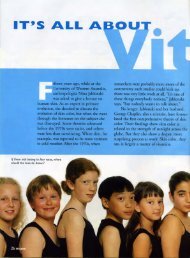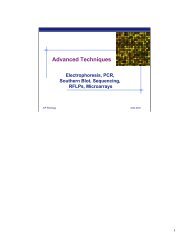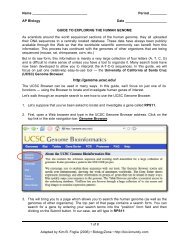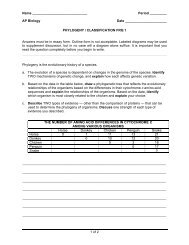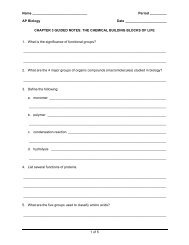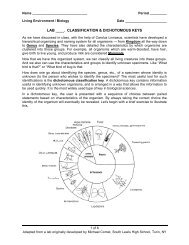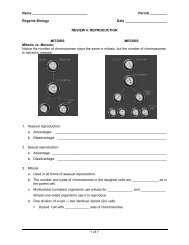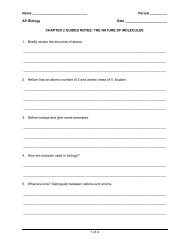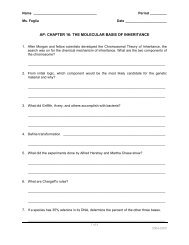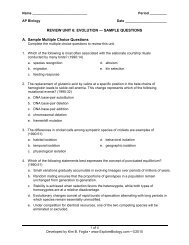8. Do individual slugs seek a “balanced diet” by periodically changing from one food preferenceto another?9. Does hairiness or fuzziness <strong>of</strong> leaves influence food choice?10. Are young leaves, or other plant parts, preferred to old?11. Are moist, fresh leaves preferred to dry ones?12. Does temperature (or light or sound) influence food consumption?13. For a cultivated plant <strong>of</strong> which only one part is eaten by humans (e.g. tomatoes, carrots), doslugs prefer the same part as humans?14. Do any plants (e.g. marigolds) suppress feeding behavior?15. As a class, are non-green parts <strong>of</strong> plants (flowers, fruits, roots) preferred to green parts?16. Will slugs eat mushrooms? Do they prefer them to green plants? Do slugs distinguish betweenpoisonous and non-poisonous mushrooms (or poisonous and non-poisonous green plants)?17. What is the effect <strong>of</strong> “food additives” (e.g., sugar, vinegar, MSG, pepper) on food choice?18. Do different species <strong>of</strong> slugs exhibit the same food preferences?19. Does a dry environment (or any other environmental variable) affect feeding behavior?• It is important for students to snap the lid <strong>of</strong> the tub on tightly after putting in the slug. <strong>Slugs</strong> areremarkably adept at squeezing through very narrow openings!• The method suggested for determining the amount <strong>of</strong> food eaten by the slugs is to measure the areaconsumed, estimated with the aid <strong>of</strong> graph paper. Since the slug’s food is <strong>of</strong>ten wet and it causesthe graph paper to become wet, it works well if you can copy the graph grid onto an acetate sheet.The plastic is transparent and easy to mark on and doesn’t fall apart when wet. It is important to usegraph paper with 1 mm rulings to insure reasonably accurate estimates. Area consumption waschosen over mass consumption as the means <strong>of</strong> estimating food intake because a) satisfactorybalances may not be readily available, and b) mass change estimates are probably less reliable thanarea change estimates because <strong>of</strong> osmotic uptake <strong>of</strong> water by plant tissue. The accuracy <strong>of</strong> areachange estimates as a measure <strong>of</strong> consumption is, <strong>of</strong> course, completely dependent on theassumption that all squares <strong>of</strong> food are <strong>of</strong> equal thickness. When the food consists <strong>of</strong> thin leaves,this assumption is probably safe, but it could be drastically in error if thicker leaves or slices <strong>of</strong>carrot, etc. are used. If plant materials requiring slicing are to be among the food choices, it may bebest for the instructor to prepare the slices before class, using a razor blade or sharp knife.• One <strong>of</strong> the most important results <strong>of</strong> this exercise is that students will be exposed to the variability<strong>of</strong> biological data. It is very possible that not all slugs will show the same feeding preferences, andthey all will certainly not consume the same amount <strong>of</strong> food. A. P. classes might be introduced tostatistical procedures such as the Chi-square, t-test, or Mann-Whitney U test, which are used toanalyze and interpret variation in quantitative data. In any case, after performing and discussing theresults <strong>of</strong> the experiments, all students should have gained an increased awareness <strong>of</strong> the importance<strong>of</strong> collecting quantitative data and <strong>of</strong> performing several replications <strong>of</strong> an experiment in order todraw reliable conclusions.©2000 CIBT <strong>Food</strong> <strong>Preferences</strong> <strong>of</strong> <strong>Slugs</strong> – Teachers Section Page 6
Answers to QuestionsPre-lab reading:1. The slug is an example <strong>of</strong> an “introduced species” that has become a pest. Can you think <strong>of</strong> otherintroduced species that have become pests?The Gypsy moth, Mediterranean fruit fly, and Japanese beetle are examples <strong>of</strong> introduced insectpest species; starlings and house sparrows are examples <strong>of</strong> exotic bird species.2. What reasons can you suggest for the fact that introduced species tend to be ecologically and/oreconomically destructive?The usual explanation for rapid population increase <strong>of</strong> an exotic species is that in its newenvironment it has escaped natural population control mechanisms, which include parasitism(disease), predation, and competition.The Vermiculturist’s Experiment:• Trial 3 Conclusions:The variable is the % sand. There is no real difference in the rate <strong>of</strong> reproduction when % sand isdecreased from 15% to 10%. The number <strong>of</strong> egg cases decreases by 2.• Trial 4 Conclusions:The variable is the amount <strong>of</strong> food supplied. There appears to be a modest increase in the rate <strong>of</strong>reproduction when the food is increased from 10 - 15 grams per square foot.• Trial 5 Conclusions:The variable is the % moisture in the soil. There is no difference in the rate <strong>of</strong> reproduction whensoil moisture is varied between 20% and 25%.• Trial 6 Conclusions:The variable is whether the soil is covered. Covering the soil leads to a significant increase in therate <strong>of</strong> reproduction.• How did the vermiculturist ensure that they had replicates? Was each trial able to be repeated?What are some assumptions the vermiculturist had to make?The conditions under which the experiment was conducted (% moisture in the soil, amount <strong>of</strong> foodgiven per square foot, etc.) were carefully recorded and monitored. It was possible to repeat theexperiment many times under the same conditions because <strong>of</strong> the detailed record keeping done bythe vermiculturist. Each trial was repeated every 24 hours for one month. Thus each trial hadapproximately 30 replicates. Some assumptions made might be: a. that the worms would continueto produce eggs after their initial production <strong>of</strong> cases; b. that the worms would not be killed by thechanges made in their environment.©2000 CIBT <strong>Food</strong> <strong>Preferences</strong> <strong>of</strong> <strong>Slugs</strong> – Teachers Section Page 7



